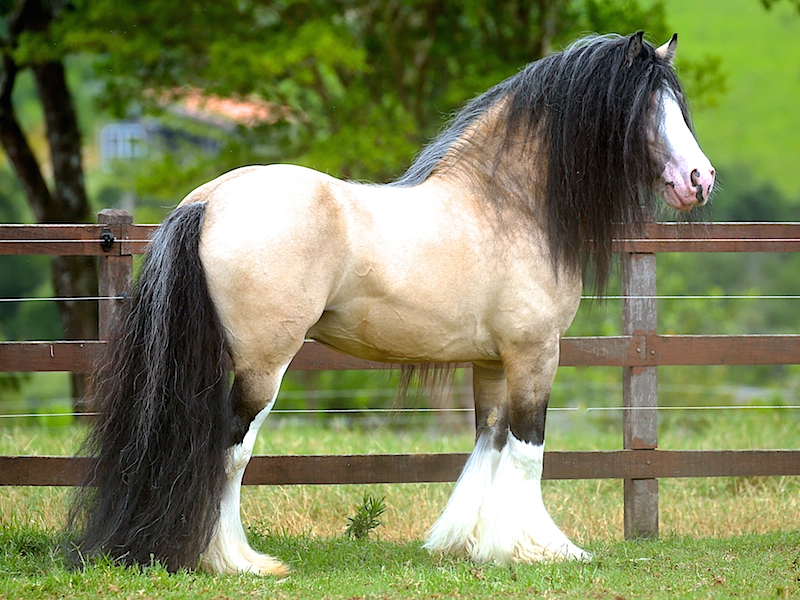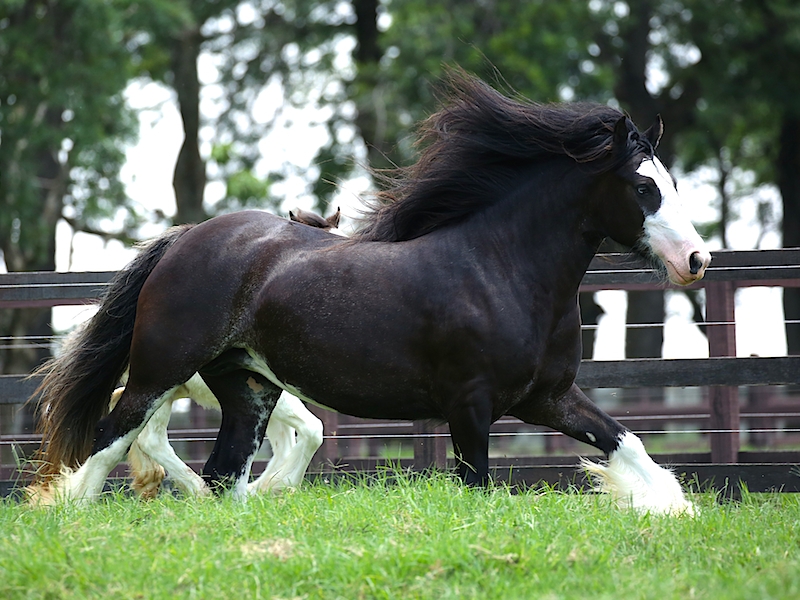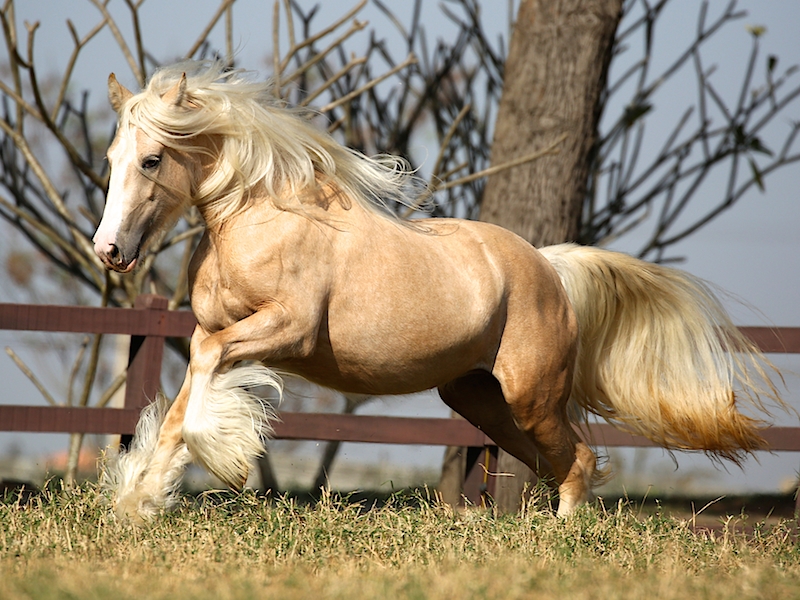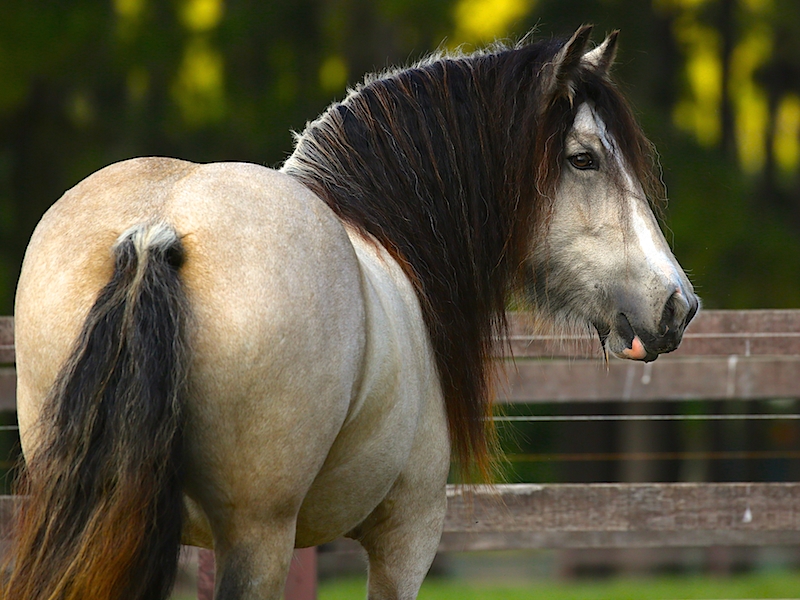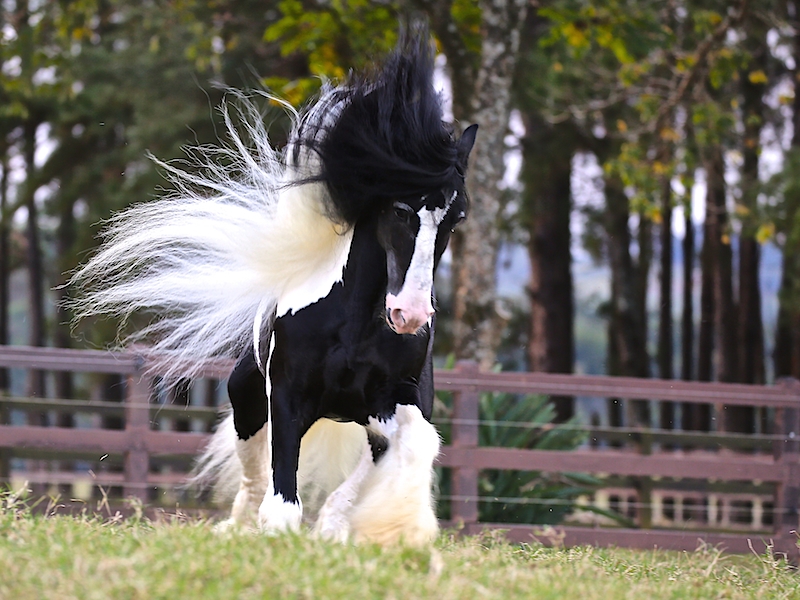The Gypsy & Irish Cob makes a perfect starter horse, especially for people who want a horse that isn?t physically challenging, is a good weight bearer and hardy in whatever size. Their extreme versatility, kindness and outstanding mental outlook make them ideal for children, pony clubs and adults alike for riding or driving either competitively or at leisure.
As a ridden horse, their wide short backs and sturdy conformation combined with the high knee action make them comfortable under saddle. They excel in the dressage arena with their instinctively high and flamboyant movements, while their natural endurance and athleticism make them equally at home out hunting or going across country and they are not put off by jumping logs, fences or ditches.
It's hard to believe that these stout, smaller horses can move so well but they are incredibly agile and combined with such a willing attitude and trainable nature, they make a formidable partner who will form a lasting relationship of trust and companionship. They are flashy, intelligent and personable but most importantly docile and forgiving, so if you are looking for a horse that is incredibly versatile and will be a faithful companion to you and your family, the Gypsy & Irish Cob may just be the perfect horse for you!
-
Origin
-
The Traditional Heavy Cob breed was developed by the Farmers and Travellers Community in Ireland, which call them as “Irish Cob”, the UK has been the first country to import them out of Ireland, which also were the major expanders of the breed worldwide and renamed them as “Gypsy Cob”, for decades these sturdy, hardworking horses were very helpful in the farmers life, pulling carts, ploughing fields and wagons throughout Ireland, Britain and Europe, being adapted to be strong, versatile, gentle enough to be handled by children but sturdy enough to pull a wagon or work the all day long.
It is assumed the native Irish breeds that gave rise to many other breeds were also the same one that originated the Traditional Heavy Cob, they bred them very selectively but did not keep written records, the lineages has being passed on verbally from generation to generation. If any horses showed temperament problems or had bad manners, they were immediately removed from the breeding program, bad temperaments were simply not tolerated, consequently the horses have long been prized for their intelligent, willing temperament their athletic ability and extraordinary good looks, being recognized as one of the most docile and beautiful breeds in the world.
Because of all these skills and exquisite beauty, they were imported to USA at 2000’s and gained a third name as “Gypsy Vanner”, the breed become a sensation in North America and in a few years later was imported to Mexico, Colombia, Brazil, New Zealand, Australia and others countries over the world. Currently the breed continues to expand abruptly throughout the world, being a trend in the equestrian world and enchanting new fans every day.
-
-
General appearance
-
The Gypsy & Irish Cob is compact and powerful, ample both in muscle and bone, yet, with an ability to perform as a good all-purpose animal, their wide short backs make them very comfortable under saddle, making the breed ideal for leisure riders, being very good weight bearers, versatile, kind and making them very suited for children and adults for riding and driving.
Some tend to be more “stocky” than others, they are well balanced and proportioned, standing straight and square and offering an imposing appearance with a stout, powerful body, noted for their high knee action, excellent temperament and flowing hair, the mane are extremely long and their tails can drag on the floor, often the long hairs (like "beard" and "mustache") giving them a look of ancient wisdom, but more importantly is the amount of "hairs" (also called "feather") from the knees and hocks until all around the hoof. If this is not full and large then this is not a high quality horse.
-
-
Breed standard
-
TOPLINE - The head, which should be held proudly, should be carried on a powerful and arched, well “set on”, neck. The neck should appear to “carry on” through good withers and to finish at the start of the back (this feature should be particularly evident in stallions). The back which should be short and straight should slope gently upwards to a well muscled croup (the back bone/spine or the hip bones should not be apparent). The croup, which is quite high and generous should have both croup muscles well defined, the top of the quarters being exceptionally well muscled, broad and ample. The angle of the spine from the croup to the tail should slope gently downwards and should not be exaggerated; this allows for a high, well “set on”, tail and contributes to good well rounded quarters.
BONE - Medium weight to heavy weight
IN MOTION – A unique action, luxuriant hair and feathering and the large range of colors available, combine to present a beautiful and varied sight to see when turned out at their best, particularly when in motion.
TEMPERAMENT - They should possess a docile and willing nature, with a friendly disposition towards humans and other animal species.
HEIGHT – under 170cms / 17hh
HEAD - should be straight, handsome and in proportion to the rest of the horse. The forehead should be broad and the muzzle, jaw and cheek should be generous.
MOUTH - should have a level bite.
EYES – should be quite bold, open and set well apart.
EARS - should be neat and well set on.
NECK - should be compact, but not too short and should be generously muscled including the crest (stallion’s necks should be particularly well muscled and crested).
SHOULDERS - should be ample, powerful and sloping.
WITHERS - should be of average protrusion or height and should be encased in plenty of muscle and flesh.
CHEST - should be powerful, well muscled and not too broad or narrow.
BACK - should be short, straight, well covered in muscle and flesh and slope gently upwards towards the croup.
HINDQUARTERS AND HIND LEGS – The hindquarters should be very generous, well rounded, broad and powerful with a well muscled high croup. The second thigh should also be very generous, quite long and well coupled to good straight powerful hocks. The hind legs should be well boned and muscled.
BODY - should be short and compact with ribs well sprung to barrel shape.
FORELEGS - should be powerful and not too short. There should be a good length of well muscled forearm and generously boned shins.
KNEES AND HOCKS - should be well developed and of generous dimensions but should be in balance with the proportions of the horse.
FETLOCK JOINTS - should match the other joints in power, size and build.
PASTERNS - should also be of sufficient bone and not too long (straight or over angled pasterns are a fault).
HOOVES - should be well shaped, neat and of a size capable of carrying the frame of the horse without stress.
LEG HAIR/FEATHERING - Leg hair/feathering is a characteristic and decorative feature of the breed. This is especially prominent in the heavier ones, however, the amount of leg hair/feathering present may vary considerably, particularly in the case of medium weight ones. Leg hair/feathering, should at the very least, fall from the back of the knees and hocks, down to a thick covering of hair/feathers on the heels. Leg hair/feathering should also fall over the front of the hoof, from at least the coronet.
MANE AND TAIL - The mane and tail should be luxuriant and capable of growing to a substantial length.
MOVEMENT – Movement should appear sound and free from obvious hereditary defects.
COLORS – All coat colors are accepted
-

